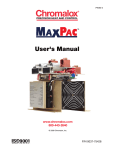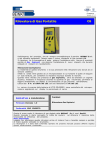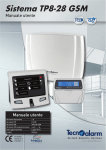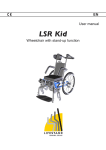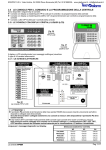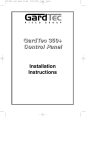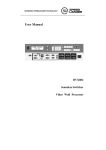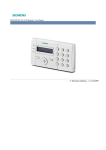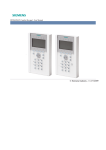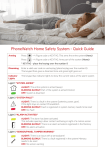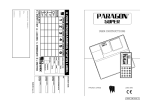Download TP8-28 - Mini Guida Utente (multilingua).indd
Transcript
TP8-28 - TP8-28 GSM Expandable serial alarm systems User quick guide Release: FW version: Control panel versions: Programming SW version: Update: Language: 1.0 0.2.00 TP8-28 - TP8-28 GSM 4.45 12/2013 English CONFORMITY The present equipment is in compliance with the essential requirements and other relevant provisions of the R&TTE 1999/05/EC directive. The equipment is also in compliance with the standard EN 50131-1. The declaration of conformity is available on the website: www.tecnoalarm.com. The product features can be subject to change without notice. Unauthorized reproduction or distribution of this manual, or any portion of it, on any device and in any form, is prohibited. The contents of this manual may be subject to change without notice. TP8-28 - TP8-28 GSM INDEX 1 - CONSOLES 1-1 LCD300/S 5 1-2 LCDPROX1 7 2 - ARMING WITH CODE 2-1 Arming 11 2-2 Disarming 11 2-3 Direct arming 12 2-4 Direct disarming 12 2-5 Arming with exclusion of the open zones 13 2-6 Hold-up alarm activation 13 2-7 Panic alarm activation 14 2-8 Consultation of the stored alarms 14 2-9 Consultation of the event log 14 TP8-28 - TP8-28 GSM 3 4 TP8-28 - TP8-28 GSM 1 - CONSOLES 1-1 - LCD300/S The LCD300/S console permits arming and disarming of the system’s programs, activation and deactivation of the remote controls and gives access to the programming menus of the system. The console is equipped with two groups of LED: the first one, below the display, is composed of 6 LED that provides general trouble and status signaling. The second group, below the keys, is composed of 15 pairs of LED and views the program states and alarms. Trouble (yellow LED) Off Blinking quickly Blinking slowly On CM No trouble Active trouble Active GSM trouble Stored trouble Tue 10 JAN 12 Work. 13:46 + Off Blinking On Off Blinking On Console not in use Console in use Tamper alarm (red LED) Off Blinking slowly On Battery OK Low battery Battery fault No alarm Active alarm Stored alarm Mains voltage (green LED) Off On No alarm Active alarm Stored alarm Program status (yellow LED) Off Blinking quickly Blinking slowly On Battery status (yellow LED) Power failure alarm (yellow LED) CM - Command mode (green LED) Off On - Program disarmed Arming phase Program partset Program armed Mains voltage absent Mains voltage present Program alarm (red LED) Off Blinking On No alarm Alarm active Stored alarm Signaling LED Trouble LED The system constantly controls its functioning. Any trouble is immediately signaled. In case of active trouble the LED is blinking, at the end of the alarm, it is switched on permanently to signal that the alarm has been stored. The stored alarm signal continues until it is cancelled with the appropriated procedure. The troubles are also stored into the event buffer of the system. Blinking quickly: Trouble of the system’s GSM module Blinking slowly: General trouble of the system. CM CM LED The CM LED (command mode) is lit as soon as the user starts typing on the keys. It is lit during the entire access time and during 10 seconds after the last keystroke. When the LED is switched off, the user must enter the access code again to have access to the console. TP8-28 - TP8-28 GSM 5 Tamper alarm LED The LED signals the tamper alarms of the system. The system’s anti-tamper protection is always active and is independent from the program status. Off: No tamper alarm Blinking: Active tamper alarm On: Stored alarm. The stored alarm signal continues until it is cancelled with the appropriated procedure - Battery status LED The LED signals the status of the system’s battery. Off - Battery OK Blinking – Low battery On - Battery fault, i.e. the battery is no longer able to support the system + Power failure alarm LED The LED signals the failure of mains power (230V AC). Off - No alarm (mains power OK) Blinking - Active power failure alarm On - Stored alarm. The stored alarm signal continues until it is cancelled with the appropriated procedure Mains voltage LED The LED signals the presence of mains voltage (230V AC). Off - Mains voltage absent On - Mains voltage present Program status LED The LED signal the following states of each program: disarmed, arming phase, armed and partset. During the 10 seconds arming phase of the program, the corresponding LED is blinking quickly and it is possible to arm/disarm other programs and exclude the open zones from the alarm detection. Off - Program disarmed Blinking quickly - Arming phase of the program (10 seconds) Blinking slowly - Program partset On - Program armed Yellow LED Program alarm LED The alarm is only signaled if the program is armed. Off - No alarm program Blinking - Active program alarm On - Stored alarm. The signal of stored alarm continues until the following arming Red LED 6 TP8-28 - TP8-28 GSM 1-2 - LCDPROX1 The LCDPROX1 console permits arming and disarming of the system’s programs, activation and deactivation of the remote controls and gives access to the programming menus of the system. The console is equipped with two groups of LED: the first one, situated on the right of the display, is composed of 7 LED which provide general trouble and status signaling. The second group, on the left of the keys, is composed of 8 pairs of LED and views the program status. Trouble (yellow LED) Battery status (yellow LED) Off No trouble Off Battery OK Blinking quickly Active trouble Blinking Low battery Blinking slowly Active GSM trouble On Battery fault On Stored trouble CM Tue 10 JAN 12 Work. 13:46 1 234 5678 Power failure alarm (yellow LED) CM - Command mode (green LED) Off No alarm Off Console not in use Blinking Active alarm On Console in use On Stored alarm Mains voltage (green LED) Tamper alarm (red LED) Off No alarm Off Mains voltage absent Blinking slowly Active alarm On Mains voltage present On Stored alarm Transponder (blue LED) 1 1 2 3 4 5 6 7 8 Program status (yellow LED) Program disarmed Off No alarm Blinking quickly Arming phase Blinking Alarm active Blinking slowly Program partset On Stored alarm On Program armed Trouble and tamper icons Low battery General alarm Tamper Power failure Provider and signal power signaling G ***** G I VOD No transponder read and recognized Transponder read and recognized Program alarm (red LED) 1 Off Program status signaling The display shows eight icons indicating as many programs. The icon is only viewed if the corresponding program is armed. Off Blinks once Signaling LED and icons The LCDPROX1 console signals the system status through LED and specific icons which are viewed on the right hand side of the display. There are two groups of icons which are displayed alternately according to the operating mode. The first group of icons represents the programs and for each of them indicates the following states: armed, disarmed, partset and arming phase. The second group signals trouble (general alarm) and tamper. The icons are only displayed if a trouble occurs. Warning: In case of simultaneous signaling, the program status icons always have priority over the trouble icons. The display views the name of the provider and quality of the available signal. Both information are alternately viewed. N.B. This function is only available for control panels with GSM interface TP8-28 - TP8-28 GSM 7 Trouble LED The system constantly controls its functioning. The occurrence of a trouble is immediately signaled. In case of active trouble the LED is blinking, at the end of the alarm, it is switched on permanently to signal that the alarm has been stored. The stored alarm signal continues until it is cancelled with the appropriated procedure. The troubles are also stored into the event buffer of the system. Blinking slowly - General trouble of the system Blinking quickly - Trouble of the system’s GSM module. CM LED The CM LED (command mode) is lit as soon as the user starts typing on the keys. It is lit during the entire access time and during 10 seconds after the last keystroke. When the LED is switched off, the user must enter the access code again to have access to the console. CM Tamper alarm LED The LED signals the tamper alarms of the system. The system’s anti-tamper protection is always active and is independent from the program status. Off - No tamper alarm Blinking - Active tamper alarm On - Stored alarm. The stored alarm signal continues until it is cancelled with the appropriated procedure Battery status LED The LED indicates the status of the system’s battery. Off - Battery OK Blinking - Low battery On - Battery fault, i.e. the battery is no longer able to support the system. Power failure alarm LED The LED signals the failure of mains power (230V AC). Off - No alarm (mains power OK) Blinking - Active power failure alarm On - Stored alarm. The stored alarm signal continues until it is cancelled with the appropriated procedure Mains voltage LED The LED signals the presence of mains voltage (230V AC). Off - Mains voltage absent On - Mains voltage present Transponder LED The LED signals that a transponder has been read and recognized by the integrated reader. Off - No transponder read or recognized Blinking once - Transponder read and recognized 1 1 Yellow LED Red LED 8 Program status LED The LED signal the following states of each program: disarmed, arming phase, armed and partset. During the 10 seconds arming phase of the program, the corresponding LED is blinking quickly and it is possible to arm/disarm other programs and exclude the open zones from the alarm detection. Off - Program disarmed Blinking quickly - Arming phase of the program (10 seconds) Blinking slowly - Program partset On - Program armed Pogram alarm LED The alarm is only signaled if the program is armed. Off - No alarm program Blinking - Active program alarm On - Stored alarm. The signal of stored alarm continues until the following arming. TP8-28 - TP8-28 GSM Use of the transponder Since the LCDPROX1 console is equipped with a transponder reader, it also permits arming and disarming the programs using a transponder instead of the access code. The procedure is explaining below. Tue 10 JAN 12 Work. 13:46 Managed programs The console permits arming/disarming of the programs defined by the installer. 1 2 3 4 5 6 7 8 1 5 1 2 3 MEM 2 6 4 5 6 EXIT 3 7 7 8 9 8 NO 0 YES 4 * Reading of the transponder The transponder is read as soon as it is approached to the RFID field of the console. When the transponder is recognized as valid, the transponder LED blinks once. RFID field of the transponder CM MENU # Warning: The transponder is only read very close to the RFID field Arming Arming is made in three phases: A - Reading of the transponder B - Selection of the programs to be armed C - Confirmation Arming of the program with transponder A Approach the transponder to the RFID field. Verify that the blue LED blinks once (transponder recognized). Remove the transponder. B Select the program/s to be armed. C Press YES to confirm and quit. A Approach the transponder to the RFID field. Verify that the blue LED blinks once (transponder recognized). Remove the transponder. B Select the program/s to be disarmed. C Press YES to confirm and quit. Tue Work. 1 ...... 8 10 JAN 12 22:00 ACCESS Key 1 Mar 10 JAN 12 Work. 22:00 YES 1 8 Disarming of the program with transponder Mar 10 JAN 12 Work. 22:00 1 ...... 8 1 8 ACCESS Key 1 Tue Work. YES Disarming Disarming is made in three phases: A - Reading of the transponder B - Selection of the programs to be disarmed C - Confirmation 10 JAN 12 22:00 N.B. The recognition of a valid transponder automatically switches off the program alarms without entering the corresponding program number. Warning: The "Disarming confirmation" functions only if activated by the installer. Confirmation of disarming (blocking of hold-up alarm) A Approach the transponder to the RFID field. Verify that the blue LED blinks once (transponder recognized). Remove the transponder. B Select the program/s to be disarmed. C Press YES to confirm and quit. D Confirm disarming within the programmed Disarming confirmation delay by entering a valid user code (see note). Mar 10 JAN 12 Work. 22:00 1 ...... 8 2 3 8 ACCESS Key 1 YES 1 1 4 5 Tue Work. 10 JAN 12 22:00 Tue Work. 10 JAN 12 22:00 Disarming confirmation The disarming confirmation is made in four phases: A - Reading of the transponder B - Selection of the programs to be disarmed C - Confirmation D - Confirmation of disarming with access code N.B. If the user code is not entered during the programmed Disarming confirmation delay, a hold-up alarm is released. N.B. The Confirmation of disarming only functions if the transponder has been programmed with this attribute. TP8-28 - TP8-28 GSM 9 10 TP8-28 - TP8-28 GSM 2 - ARMING WITH CODE 2-1 - Arming It is possible to select which programs to arm. Tue 21 FEB 12 Work. 12:15 Enter the access code 1 2 In case of error, abort the process by T EXIT within 5 seconds, then restart pressing 3 Arming is made in three phases: A - Entering of the code B - Selection of the programs to be armed C - Confirmation 4 5 While entering the code, on the display is viewed Complete password Complete Password Once the code has been entered, on the display is viewed ACCESS ACCESS Master On the display is viewed Arming followed by the programs Arming Program 1 On the display is viewed the confirmation of arming Arming Control panel OK Select the programs to be armed Confirm arming of the programs 1 3 YES The programs 1 and 3 are armed Tue 21 FEB 12 Work. 12:15 2-2 - Disarming It is possible to select which programs to disarm. Tue 21 FEB 12 Work. 12:15 Enter the access code 1 2 In case of error, abort the process by pressing EXIT within 5 seconds, then restart 3 4 Disarming is made in three phases: A - Entering of the code B - Selection of the programs to be disarmed C - Confirmation 5 While entering the code, on the display is viewed Complete password Complete Password Once the code has been entered, on the display is viewed ACCESS ACCESS Master Select the programs to be disarmed On the display is viewed Disarming followed by the programs Disarming Program 1 Confirm disarming of the programs Tue 21 FEB 12 Work. 12:15 TP8-28 - TP8-28 GSM 1 3 YES The programs 1 and 3 are disarmed 11 2-3 - Direct arming It is possible to simultaneously arm all the programs associated to the code. Tue 21 FEB 12 Work. 12:15 Enter the access code 1 2 In case of error, abort the process by pressing EXIT within 5 seconds, then restart 3 Arming is made in two phases: A - Entering of the code B - Confirmation 4 5 While entering the code, on the display is viewed Complete password Complete Password Once the code has been entered, on the display is viewed ACCESS ACCESS Master On the display is viewed the confirmation of arming Arming Control panel OK Arm all the programs associated to the code YES All the programs associated to the code are armed Tue 21 FEB 12 Work. 12:15 2-4 - Direct disarming It is possible to simultaneously disarm all the programs associated to the code. Tue 21 FEB 12 Work. 12:15 Enter the access code 1 2 In case of error, abort the process by pressing EXIT within 5 seconds, then restart 3 Disarming is made in two phases: A - Entering of the code B - Confirmation 4 5 While entering the code, on the display is viewed Complete password Complete Password Once the code has been entered, on the display is viewed ACCESS ACCESS Master Tue 21 FEB 12 Work. 12:15 12 Disarm all the programs associated to the code NO All the programs associated to the code are disarmed TP8-28 - TP8-28 GSM 2-5 - Arming with exclusion of the open zones Only the enabled codes can arm a program excluding possible open zones. The procedure is described considering the conventional arming which permits the selection of the programs to be armed. Tue 21 FEB 12 Work. 12:15 1 Enter the access code 2 3 In case of error, abort the process by pressing EXIT within 5 seconds, then restart 4 5 While entering the code, on the display is viewed Complete password Complete Password Once the code has been entered, on the display is viewed ACCESS ACCESS Master Select the programs to be armed On the display is viewed Arming followed by the programs Arming Program 1 Confirm the arming of the programs YES YES Arming is made in four phases: A - Entering of the code B - Selection of the programs to be armed C - Confirmation D - The console signals the open zones acoustically and visually. Press the YES key again to stop all the signaling. The selected programs are armed and the open zones are excluded 1 3 The open zones are viewed the display and announced by the speaker of the console Open zones Window kitchen To stop signaling of the open zones and arm On the display is viewed the confirmation of arming of the control panel and exclusion of the open zones Arming Control panel OK The programs 1 and 3 are armed and the open zones are excluded Tue 21 FEB 12 Work. 12:15 2-6 - Hold-up alarm activation Only the enabled codes can active a hold-up alarm. Under duress, it is possible to disarm the system apparently and activate the programmed hold-up signaling by reducing by one unit the last digit of the code. 1 2 3 4 5 1 2 3 4 4 TP8-28 - TP8-28 GSM For example, if the access code is 12345, to release the hold-up alarm, enter 12344. 13 2-7 - Panic alarm activation At any time, whether the system is armed or disarmed (the program status is not relevant), it is possible to release a panic alarm and activate the programmed signaling. Tue Work. To release a panic alarm, press the arrow up and down keys simultaneously. The activation mode is valid for the LCD300/S and the LCDPROX1 consoles. 10 JAN 12 13:46 2-8 - Consultation of the stored alarms The console views all the alarms which have occurred during the last arming session. The stored alarms are viewed until the next arming of a program. As soon as any of the programs is armed, the memory is automatically reset to memorize the events of the new functioning session. Tue 21 FEB 12 Work. 12:15 Consultation of the stored alarms To consult the memory, press MEM If the memory is empty, on the display is viewed "None" If the memory contains alarms, they are displayed in sequence one at a time. MEM Viewing Control panel ALARM MEM None 2-9 - Consultation of the event log The control panel stores all the events regarding functioning, management and alarms in its event buffer. Its storage capacity is 1,500 events. Once the memory is full, for every new event the oldest one is overwritten. Tue 21 FEB 12 Work. 12:15 ACCESS Master Enter the access code 1 2 3 4 5 Consultation of the event log Enter the access code Press MEM Press the arrow key MEM Use the arrow keys to consult the events For each event the date and hour of occurrence are stored. The second line of the display shows the description of the event. Viewing Events Previous event Press EXIT to quit the event log. 03/02 10:20:23 ACCESS EXIT Next event Tue 21 FEB 12 Work. 12:15 14 TP8-28 - TP8-28 GSM TP8-28 - TP8-28 GSM 15 Copyright© 2013 Tecnoalarm s.r.l. All rights reserved. Document edited by the Technical Documentation Department. Last update: 12/2013 Via Ciriè, 38 - 10099 San Mauro T.se - Torino (Italy) tel. +390112235410 - fax +390112735590 [email protected] www.tecnoalarm.com 495, Rue Antoine Pinay - 69740 Genas - Lyon (France) tél. +33478406525 - fax +33478406746 [email protected] www.tecnoalarm.com Agence de Paris: 125, Rue Louis Roche - 92230 Gennevilliers c/Vapor 18 (Pol. Ind. El Regas) 08850 Gavá - Barcelona (España) tel. +34936622417 [email protected] www.tecnoalarm.com


















